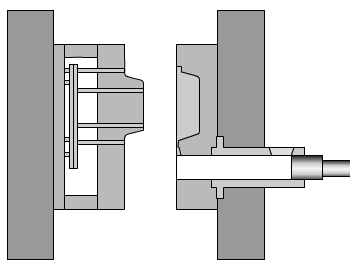Die casting process
The essence of pressure casting (referred to as die casting) is to fill the die-casting cavity with liquid or semi-liquid metal at a higher speed under high pressure, and form and solidify under pressure to obtain castings.
Die casting Features
High pressure and high speed filling die casting are the two major characteristics of die casting. Its commonly used injection pressure is from several thousand to several tens of thousands kPa, even as high as 2×105kPa. The filling speed is about 10~50m/s, and in some cases it can even reach more than 100m/s. The filling time is very short, generally in the range of 0.01~0.2s. Compared with other casting methods, die casting has the following three advantages
The advantage
1. Good product quality
The dimensional accuracy of castings is high, generally equivalent to 6~7, or even up to 4; the surface finish is good, generally equivalent to 5~8; the strength and hardness are higher, and the strength is generally 25~30% higher than sand casting, but it is extended The rate is reduced by about 70%; the size is stable, and the interchangeability is good; it can die-cast thin-walled complex castings. For example, the current minimum wall thickness of zinc alloy die castings can reach 0.3 mm; aluminum alloy castings can reach 0.5 mm; the minimum casting aperture is 0.7 mm; and the minimum pitch is 0.75 mm.
2. High production efficiency
The machine productivity is high. For example, the domestic JⅢ3 horizontal cold-air die casting machine can die-cast 600-700 times in eight hours on average, and the small hot-chamber die-casting machine can die-cast 3,000-7000 times every eight hours on average. The die-cast clock alloy has a life span of hundreds of thousands of times, even millions of times; it is easy to realize mechanization and automation.
3. Excellent economic effect
Due to the precise dimensions of the die-casting parts, the surface is bright and clean. Generally, it is not used for mechanical processing and directly used, or the processing volume is small, so it not only improves the utilization rate of metal, but also reduces a large number of processing equipment and man-hours; the price of castings is easy; combination die-casting can be used to use other metal or non-metal materials . It saves not only assembly man-hours but also metal.
Although die casting has many advantages, there are also some shortcomings that need to be resolved.
The shortcoming
1). Due to the high speed of liquid metal filling the cavity during die-casting, the fluid state is unstable, so the general die-casting method is used, and the casting is prone to pores and cannot be heat treated;
2). Die-casting is more difficult for castings with complex recesses;
3). High melting point alloys (such as copper, ferrous metals), die-casting mold life is relatively low;
4). It is not suitable for small batch production. The main reasons are the high manufacturing cost of die-casting molds, the high production efficiency of die-casting machines, and the uneconomical production of small batches.
Die casting application scope and development trend
Die casting is one of the most advanced metal forming methods. It is an effective way to achieve less chips and no chips. It has a wide range of applications and is developing rapidly. The size and weight of the casting depends on the power of the die casting machine. As the power of the die-casting machine continues to increase, the shape and size of the casting can range from a few millimeters to 1 to 2 m; the weight can range from a few grams to tens of kilograms. Foreign aluminum castings can be die-cast with a diameter of 2m and a weight of 50kg.
Die-casting parts are no longer limited to the automobile industry and instrument industry, and gradually expanded to other industrial sectors, such as agricultural machinery, machine tool industry, electronics industry, defense industry, computers, medical equipment, clocks, cameras, and daily hardware, etc. Industry, specifically: auto parts, furniture accessories, bathroom accessories (bathroom), lighting parts, toys, shavers, tie clips, electrical and electronic parts, belt buckles, watch cases, metal buckles, locks, zippers, etc. In terms of die-casting technology, new processes such as vacuum die-casting, oxygen-added die-casting, precision fast-dense die-casting, and the application of soluble cores have emerged.
It will have a very good promotion effect on China’s die-casting industry.







